When I was a child, our entire neighborhood was filled with children around the same ages as my siblings and me. We loved to spend our summer days and evenings playing games: board games, kickball in the street, hide and go seek in the neighborhood, Red Light-Green Light, Red Rover, ping pong, etc. I want my grands to know and play lots of games too, so I planned an In-Home Day Camp experience for them that focuses on sports and games. Since this is also a Summer Olympic year, I decided to incorporate the Olympics into this day camp as well.
As I planned this day camp theme for the grands, Tigger (8), Kona (6), and Tahoe (4), I designed activities for each of the eight Multiple Intelligences. I also incorporated some academic focus in the activities I chose.
I have planned four weeks of day camp activities altogether and this theme is for Week Two. If you would like to see Week One’s day camp plans, you can find it here:
In the coming weeks I will also post my plans for Week Three and Week Four:
Week Three Theme: We Like Bikes
Week Four: Water, Water, Everywhere
Week Two: The Game Plan
The weekly schedule: Each day I will “dip into” the Read Aloud Book (see Linguistic Intelligence) and have the grands (or day campers) play at least two different games (found in several places in this post). By the end of the week I will make sure that I have offered at least one activity from each intelligence so that all eight intelligences are covered by the end of this day camp unit. I will also mention any academic focus I plan on integrating into any of the activities.
Linguistic Intelligence (Word Smart)
Read and discuss books- It’s always nice to include books as part of the day camp experience. I usually get my books from the library. During the week these books may be used to go along with the theme:
Nonfiction:
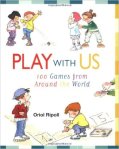 Play With Us: 100 Games from Around the World by Oriol Ripoll is a great resource explaining both indoor and outdoor games from many countries. There are a variety of types of games too such as hopscotch, marble games, hide and seek, and tag. Academic Focus: Following written directions-First, I’ll point out that directions for games usually include the number of players, materials needed, and steps in the game. I’ll have the grands choose a few games from this book and follow the directions to play them. (The oldest grandson can read it to the other two grands.)
Play With Us: 100 Games from Around the World by Oriol Ripoll is a great resource explaining both indoor and outdoor games from many countries. There are a variety of types of games too such as hopscotch, marble games, hide and seek, and tag. Academic Focus: Following written directions-First, I’ll point out that directions for games usually include the number of players, materials needed, and steps in the game. I’ll have the grands choose a few games from this book and follow the directions to play them. (The oldest grandson can read it to the other two grands.)
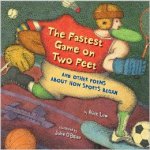 The Fastest Game on Two Feet and other Poems about How Sports Began by Alice Low uses poetry to explain the origins of some sports and games that require legwork. (Many of these sports are also played during the Olympics). Some of the sports included are running, gymnastics, bowling, figure skating, and rugby. This book is written at a higher level, but I think my oldest grandson will enjoy it. Academic focus: Rhyming words: Many of the poems in this book are rhymes, so identifying rhyming words is definitely a literacy skill to practice when reading this book.
The Fastest Game on Two Feet and other Poems about How Sports Began by Alice Low uses poetry to explain the origins of some sports and games that require legwork. (Many of these sports are also played during the Olympics). Some of the sports included are running, gymnastics, bowling, figure skating, and rugby. This book is written at a higher level, but I think my oldest grandson will enjoy it. Academic focus: Rhyming words: Many of the poems in this book are rhymes, so identifying rhyming words is definitely a literacy skill to practice when reading this book.
Fiction:
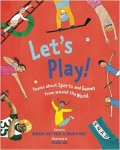 Let’s Play: Poems about Sports and Games from Around the World edited by Debjaniu Chatterjee and Brian D’Arcy contains over thirty poems about a variety of sports, mostly from English speaking countries such as USA, UK, and India. Some of the poems were familiar to me: “Take Me Out to the Ball Game” and “The Swing.” Most of the poems are new to me including: “The Skater Boys” and “Right Royal.” Sports and games that have inspired these poems include ping pong, judo, boxing, diving, cycling, American football, and cricket. Academic Focus: Context clues–Are there unfamiliar words in the poems, especially those written in other countries? What clues can we find in the prose to help us uncover the meaning of these unfamiliar words?
Let’s Play: Poems about Sports and Games from Around the World edited by Debjaniu Chatterjee and Brian D’Arcy contains over thirty poems about a variety of sports, mostly from English speaking countries such as USA, UK, and India. Some of the poems were familiar to me: “Take Me Out to the Ball Game” and “The Swing.” Most of the poems are new to me including: “The Skater Boys” and “Right Royal.” Sports and games that have inspired these poems include ping pong, judo, boxing, diving, cycling, American football, and cricket. Academic Focus: Context clues–Are there unfamiliar words in the poems, especially those written in other countries? What clues can we find in the prose to help us uncover the meaning of these unfamiliar words?
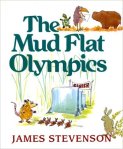 The Mud Flat Olympics by James Stevenson is an easy and adorable chapter book about some animals that are holding an Olympics. The events are varied including Digging the Deepest Hole (which featured the moles) and the All-Snail High Hurdles. Academic focus: Inferences–The animals don’t always win the races in the conventional way, so the grands will have to employ some inference skills to understand who (or how) the winners were determined.
The Mud Flat Olympics by James Stevenson is an easy and adorable chapter book about some animals that are holding an Olympics. The events are varied including Digging the Deepest Hole (which featured the moles) and the All-Snail High Hurdles. Academic focus: Inferences–The animals don’t always win the races in the conventional way, so the grands will have to employ some inference skills to understand who (or how) the winners were determined.
 Hit the Ball Duck by Jez Alborough is an adorable rhyming picture book about a group of friends who want to play baseball. However, with duck’s first hit, the baseball gets stuck high in a tree, so the friends try different methods to get it down. Academic focus: Problem and Solution-This is a great book to discuss the main problem in the story and how it is finally solved. Rhyming-Since this book is written in rhymes, I will have the grandsons identify the rhyming words. Sight words–This will be a great book for Kona to identify his sight words.
Hit the Ball Duck by Jez Alborough is an adorable rhyming picture book about a group of friends who want to play baseball. However, with duck’s first hit, the baseball gets stuck high in a tree, so the friends try different methods to get it down. Academic focus: Problem and Solution-This is a great book to discuss the main problem in the story and how it is finally solved. Rhyming-Since this book is written in rhymes, I will have the grandsons identify the rhyming words. Sight words–This will be a great book for Kona to identify his sight words.
Read Aloud:
 Going for Gold! by Andrew Donkin tells the story of six Olympians: Jesse Owens, Shelley Mann, Mamo Wolde, Daley Thompson, Jennifer Capriati, and Kerri Strug. The book includes photographs and interesting sidebars giving facts about the Olympic Games. In addition, Going for Gold! includes information about the sport of each of these athletes. Academic focus: Main Character–Discuss each Olympians’ motivation and/or obstacles in achieving their gold medal.
Going for Gold! by Andrew Donkin tells the story of six Olympians: Jesse Owens, Shelley Mann, Mamo Wolde, Daley Thompson, Jennifer Capriati, and Kerri Strug. The book includes photographs and interesting sidebars giving facts about the Olympic Games. In addition, Going for Gold! includes information about the sport of each of these athletes. Academic focus: Main Character–Discuss each Olympians’ motivation and/or obstacles in achieving their gold medal.
Poetry Recitation: The grands are really into memorizing short poems at the moment (encouraged by their parents) so I’d like to have each of them choose one of the poems in Let’s Play: Poems about Sports and Games from Around the World or The Fastest Game on Two Feet and other Poems about How Sports Began and memorize it.
Storytelling or Writing Prompts: I will give my grandsons at least one of these prompts and have them tell me a story (or write it down depending on their interest or age level.) Academic focus: Main Characters and Plot (Complete sentences if used as a written activity.)
- I wanted to be the best _______ player in town, so I made a plan.
- Mom and Dad surprised us one morning by saying they had some tickets for the Summer Olympics.
- I decided to create my own game. I called it ________ and these are the rules for the game:
Logical/Mathematical Intelligence (Number/Reasoning Smart)
Most games use some type of math anyway, but here are some games I plan to use to engage the grands’ logical/mathematical intelligence:
Basketball Shots: One of the games I will play with the grands is shooting baskets. I will have the older grands, Kona and Tigger, practice counting by 2s amd 5s by making their baskets either worth 2 points each or 5 points each.
Dominoes: A set of dominoes has many options for using math skills. First I will work with the basic rule in which the grands will have to match the number of dots on the end tiles to place a new domino. For the older grands, I will move onto the rule of 3s and 5s. For more information on this game and other ideas for using dominoes I will use this resource:
There are more ideas for game related math at this website:
http://www.mathgoodies.com/Webquests/sports/
Musical Intelligence (Music Smart)
Music has been written about games and is additionally an integral part of some games.
Songs about Games: Some samples of songs about games (baseball and Olympic in particular), that I will play for the grands are these:
- “Centerfield” by John Fogerty
- “Take Me Out to the Ballgame” by Jack Norworth, and
- “Olympic Fanfare and Theme” by John Williams.
Singing Games: There are so many traditional games that involve singing such as “The Farmer in the Dell,” “London Bridges,” and “Skip to My Lou.” I found other sources of singing games to try at these links:
http://www.songsforteaching.com/movement.htm
http://www.ashleydanyew.com/2015/15-singing-games-for-childrens-choir/
Naturalist Intelligence (Nature Smart)
So many games can be played outdoors, and I want my grands to learn a variety of them. I also want to show them that they can use natural materials as part of their play.
Shadow Tag: To play this game, find a large sunny area. Since the game requires players to step on other players’ shadows, it is probably best done in the late afternoon. This game can be done by only two participants, but it is more fun with at least three players. Shadow tag is similar to other types of “tag” games except the only way that the child who is “it” can tag another player is to step on their shadow. Then that child becomes “it” and has to try and step on someone else’s shadow. There are lots of other variations of the “tag” game. I found a great resource here:
http://www.ultimatecampresource.com/site/camp-activities/tag-games.page-1.html
Other Classic Outdoor Games: I also want to teach my grandsons some outdoor games that I loved as a child such as Kick the Can, Red Rover, and Red Light, Green Light. I found this resource which has the rules for these games as well as several others that I might try: http://www.wired.com/2013/03/30-classic-games-for-simple-outdoor-play/
Tic-Tac-Toe: I want the grands to understand that natural materials can be used in place of paper and pencil to play some familiar games. For example, I’ll have the grands collect long sticks to make the grid for tic-tac-toe. Then the grands can gather natural items for the “X” and “O” pieces by collecting items such as rocks, bark, or pinecones.
Other games using natural materials can be found at this website: http://artfulparent.com/2014/05/10-diy-outdoor-games-to-make-rocks.html
Spatial Intelligence (Picture Smart)
One of my favorite childhood games uses the Spatial Intelligence as part of its playing area.
Hopscotch: Information on the more traditional hopscotch games can be found at this 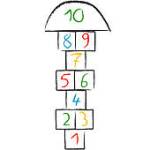 website: http://www.parents.com/fun/activities/hopscotch/
website: http://www.parents.com/fun/activities/hopscotch/
I also found a different type of hopscotch using the book, Play With Us (see Linguistic Intelligence), where the player kicks a stone instead of hopping from each numbered space. The game is called “Kicking the Pebbles” and uses a different type of hopscotch formation: a large square playing area that has been divided into 8 different five sided or four sided spaces with some chalk. The player throws a “pebble” into space #1 and then tries to kick the stone from space to space in number order until the player gets to the end. If the player is successful to getting to the end without kicking the stone out of a space, then they get a second round by throwing the “pebble” into space #2 and repeating the pattern of kicking the stone from space to space in number order.
Treasure Hunt: My grandson, Kona, just loves to follow maps so I will include at least one treasure hunt during this day camp week. The first time we play the game, I will hide one of their toys as the “treasure” and draw a map for the boys to follow to find the toy. In subsequent games, I will have the grandsons take turns hiding the “treasure” and creating a map. (I’ll have someone help Tahoe when it is his turn.)
Olympic Ring Craft: I discovered an idea for a craft from another blogger. This idea uses bottle caps to create the Olympic rings. It can be found at this link: http://www.icanteachmychild.com/olympic-rings-cap-sorting/
Interpersonal Intelligence (People Smart)
 Many of the games listed in other places in this post would also fit under the Interpersonal Intelligence because you need more that one person to play these games. Besides those activities, other examples of interpersonal games that I plan to include in my day camp week would be Hide and Seek, Mother May I, board games (like Checkers), and card games like “Go Fish.”
Many of the games listed in other places in this post would also fit under the Interpersonal Intelligence because you need more that one person to play these games. Besides those activities, other examples of interpersonal games that I plan to include in my day camp week would be Hide and Seek, Mother May I, board games (like Checkers), and card games like “Go Fish.”
Bodily-Kinesthetic Intelligence (Body Smart)
I want my grandsons not only to enjoy playing these games, but hopefully develop some physical skills as well. That is why I will include “lead up games” in my day camp for the grands.
Red Light, Green Light Dribble: This basketball lead up game will allow the grands to practice dribbling a basketball. To play the game, each player needs a basketball. Then the grands will line up on one side of the basketball playing area and the “Leader” will be on the other side. When the “Leader” calls “Green Light” the day campers move forward while dribbling the basketball. The players must stop when the “Leader” calls “Red Light.” If a player doesn’t stop at “Red Light,” they are sent back to the beginning. The first player to catch up to the “Leader” is the winner. (I may have the youngest grandson start the game closer to the “Leader” since this skill will be more difficult for him.) I found other basketball lead up games that I might use with my grandsons at this website: http://www.csosports.org/4-fun-basketball-dribbling-games-for-young-players
Water Balloon Toss: Besides being a very cooling game for a hot summer day, this game teaches skills such as catching with two  hands and throwing with accuracy. You will need even numbers of players for this game. Day campers play with a partner and stand about three feet away from each other. Each partnership has one water balloon. At a signal, the player with the water balloon tosses it to their partner. If the partner is successful in catching the water balloon, they take a small step back and then throw the water balloon back. Play continues like this until the water balloon breaks. I plan to have lots of water balloons ready for this game so the grands get plenty of practice in throwing and catching.
hands and throwing with accuracy. You will need even numbers of players for this game. Day campers play with a partner and stand about three feet away from each other. Each partnership has one water balloon. At a signal, the player with the water balloon tosses it to their partner. If the partner is successful in catching the water balloon, they take a small step back and then throw the water balloon back. Play continues like this until the water balloon breaks. I plan to have lots of water balloons ready for this game so the grands get plenty of practice in throwing and catching.
Soccer Pirate Attack: This lead up game will help my day campers to practice their soccer dribbling skills. To play this game, you will need several hula hoops and several soccer balls. Using a large flat playing area, place the hula hoops (Safe Islands) about the field. All players start the game at the edge of the playing area. The child who is the “Pirate” has to turn around and count to ten before “attacking” the other players. Meanwhile the other players are allowed to roam and/or dribble the soccer ball around the field. Players are not allowed to touch the soccer balls with their hands. When the “Pirate” finishes counting to ten, the “Pirate” calls out “Attack” and runs to tag the players with the soccer balls. To be safe, the players with soccer balls must be inside a Safe Island with their soccer ball. Anyone who is tagged by the “Pirate” before reaching the safety of the Safe Islands (or who doesn’t have a soccer ball) becomes the new “Pirate” and the game starts over again.
Intrapersonal Intelligence (Self Smart)
While most of the games that are in this post require other people as part of the activity, there are some games and projects for this day camp experience that are Intrapersonal:
- Some games can be played with one person such as shooting baskets, single jump roping, playing with a hula hoop, hopscotch, and hitting a ball against a wall.
- Reading books about games: I will have the books I used during the week available for the grands to use and look at throughout the week.
- Journal Writing: I want to give each grand a chance to reflect on their day camp week by writing, drawing, or telling me what they enjoyed most about the games this week. (This is an activity that is best done at the end of the day camp experience.)
I hope you are finding these Multiple Intelligence activities useful as you plan day camps or lessons for children in your care. If you would like to see more of these unit studies as I create them, you can become a follower of this blog.
I love to add my blog posts to link parties such as:
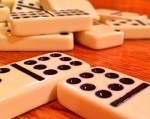
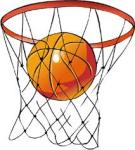













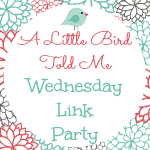

What great plans. I love all of the games.
Blessings, Dawn
LikeLike
Thank you. I am looking forward to playing all these games myself.
LikeLike
My homeschool co-op did a class based on the Play With Us book. It was super fun! Thanks for featuring these great, sporty books and sharing them at the #LMMLinkup,
LikeLike
I can definitely see using Play With Us for an entire class unit. It is a great resource. So interesting to discover that the games I played as a child are familiar games in other parts of the world…just with different names.
LikeLike
[…] In-Home Day Camp Week 2: The Game Plan […]
LikeLike
[…] In-home Day Camp Week 2: The Game Plan Jul […]
LikeLike
[…] In-home Day Camp Week 2: The Game Plan […]
LikeLike